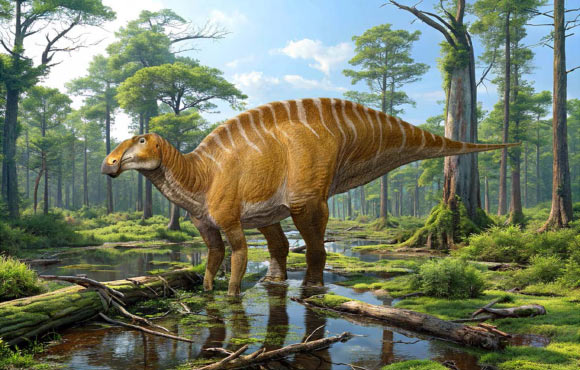A new genus and species of hadrosaurid dinosaur that lived during the Cretaceous period in what is now New Mexico has been identified and named by paleontologists from the United States and Slovak Republic.

Life reconstruction of Ahshislesaurus wimani based on the holotype and closely related species. Image credit: Sergey Krasovskiy.
“Hadrosauridae, a family of large herbivorous dinosaurs, were among the most abundant dinosaurs of Late Cretaceous terrestrial ecosystems of the Western Interior Basin of North America for about 20 million years,” said Montana State University paleontologist Sebastian Dalman and his colleagues from Harrisburg University, Penn State University, New Mexico Museum of Natural History and Pavol Jozef Šafárik University.
“This group, commonly known as the ‘duck-billed’ dinosaurs, was one of the most taxonomically diverse and successful dinosaur groups during the Cretaceous.”
“During the last 20 million years of the Cretaceous, hadrosaurids achieved a global distribution and were present in Africa, Antarctica, Asia, Europe, and North and South America.”
Named Ahshislesaurus wimani, the new hadrosaurid species lived during the Late Cretaceous, around 75 million years ago.
The dinosaur’s fossilized bones were found in the layers of the Kirtland Formation in the Ah-shi-sle-pah Wilderness, which is located in San Juan County, New Mexico, between Chaco Canyon and the De-na-zin Wilderness.
“The holotype specimen consists of an incomplete diagnostic skull, several isolated cranial elements including the right jugal, quadrate, dentary, and surangular, and a series of articulated cervical vertebrae,” the researchers said.
“In addition to the holotype, several specimens from the same layers may also belong to this newly-identified species, including a well-preserved left dentary and a partial skeleton, as well as two humeri, one belonging to a large adult and the other to a juvenile.”
In previous studies, Ahshislesaurus wimani was referred to Kritosaurus, a younger genus of saurolophine hadrosaurid from the Kirtland Formation.
Both species are relatively closely related within the hadrosaurid subfamily Saurolophinae.
However, according to the phylogenetic analysis, they represent two distinct groups that were present during the Campanian age of the Cretaceous in southern Laramidia.
“The stratigraphically younger Kritosaurus is a member of the Kritosaurini clade that includes several northern Laramidian species,” the scientists said.
“Furthermore, the phylogenetic results suggest that the clade that includes Ahshislesaurus and Naashoibitosaurus, along with two unnamed species from southern Laramidia, split from Kritosaurini during the Late Campanian (75 million years ago).”
According to the team, together with Naashoibitosaurus, Ahshislesaurus forms a potentially new group of flat-headed saurolophine hadrosaurids.
“This clade suggests the saurolophines were a taxonomically diverse group, which, during the last 20 million years of the Cretaceous, were among the dominant herbivorous dinosaurs in southern Laramidia,” the authors said.
“Recognition of a new hadrosaurid species from New Mexico also provides further evidence for latitudinal variation in the hadrosaurid fauna during the Late Cretaceous in Laramidia.”
The team’s paper will be published in the New Mexico Museum of Natural History and Science Bulletin.
_____
Sebastian Dalman et al. 2025. A new saurolophine hadrosaurid (Ornithischia: Hadrosauridae) from the Upper Cretaceous (Campanian) Hunter Wash Member, Kirtland Formation, San Juan Basin, New Mexico. New Mexico Museum of Natural History and Science Bulletin 101







